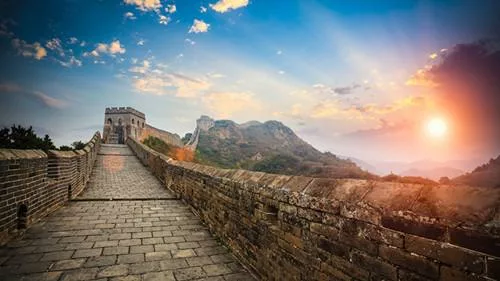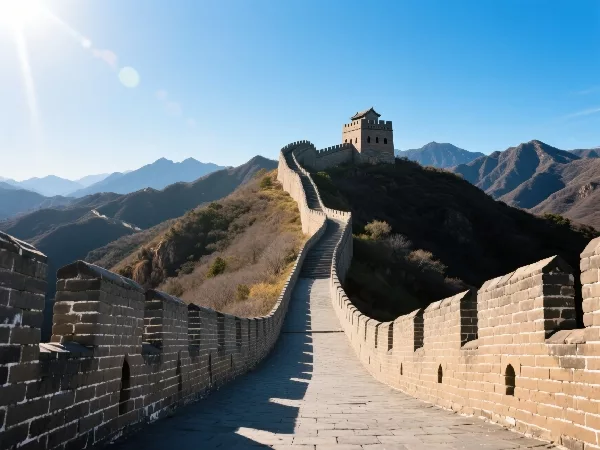
1. Unveiling the Grandeur of the Great Wall
The Great Wall of China, an iconic symbol of human ingenuity, stands as a must - visit destination for outdoor enthusiasts and history buffs from around the world. Stretching across approximately 13,171 miles, it offers a wide range of hiking opportunities, from well - trodden paths to untouched wild sections. This comprehensive guide will equip you with the knowledge to plan a safe, enjoyable, and memorable Great Wall hiking trip, ensuring you make the most of your adventure.
2. Picking the Ideal Hiking Section
2.1 Popular and Well - Maintained Areas
Mutianyu: Mutianyu is a top pick among international travelers. With fewer crowds compared to some other sections, it provides a more peaceful hiking experience. The surrounding natural scenery is simply breathtaking, with lush mountains serving as a magnificent backdrop. The presence of convenient facilities like cable cars makes it an excellent choice for families. If you have kids or elderly family members with you, they can easily reach the wall via the cable car. This allows everyone to enjoy the beauty of the Great Wall without having to endure a strenuous climb right from the start. It's also a great option for those who prefer a more relaxed hike, perhaps wanting to take their time to soak in the views and history at a leisurely pace.
Badaling: As the most famous and accessible section of the Great Wall, Badaling is a perfect starting point for first - time visitors. It has been well - preserved and offers a wide range of services and facilities. You can find souvenir shops, rest areas, and food stalls here. However, its popularity means that it can get extremely crowded, especially during peak tourist seasons and holidays. To avoid the large crowds, it's highly recommended to visit early in the morning. You'll be able to enjoy the serenity of the wall, take clear photos without hordes of people in the background, and truly feel the grandeur of this ancient wonder before the crowds arrive.
2.2 Off - the - Beaten - Path Treks
Jinshanling to Simatai: For experienced hikers seeking a more challenging and immersive experience, the Jinshanling to Simatai hike is a dream come true. This route takes you through both restored and unrestored parts of the wall. Walking along the unrestored sections gives you a raw and authentic sense of the Great Wall's history. You can see the weather - beaten bricks and the rough terrain that the wall traverses. It's a physically demanding hike, with some steep sections and uneven paths, but the rewards are well worth the effort. The views along the way are simply spectacular, and you'll likely encounter fewer tourists, allowing you to have a more personal connection with the wall.
Jiankou: If you're an adventurous soul looking for a thrilling challenge, Jiankou is the place to be. This section of the Great Wall offers some of the most dramatic and steep climbs. The paths can be narrow and in a state of disrepair in many areas, making it a bit dangerous. But for those who dare, the views are nothing short of breathtaking. The wall winds its way along the mountain ridges, offering panoramic vistas of the surrounding valleys and peaks. Due to its challenging nature and potential risks, it's highly advisable to hire a local guide. A local guide will not only know the best and safest routes to take but can also share interesting historical and cultural insights about the area that you might otherwise miss.
3. Choosing the Optimal Time to Hike
Timing is crucial when planning a Great Wall hike. The best seasons to embark on this adventure are spring, from April to May, and autumn, spanning September to October.
During spring, the Great Wall comes alive with blooming wildflowers, painting the landscape in a riot of colors. The weather is pleasantly mild, with temperatures ranging from around 50 - 70°F (10 - 21°C). This makes it comfortable to hike for extended periods without the discomfort of extreme heat or cold. The gentle breeze and longer days provide the perfect backdrop for exploring the ancient stones and taking in the historical significance of the wall.
Autumn, on the other hand, offers a different kind of beauty. The leaves on the surrounding trees turn into a palette of red, orange, and gold, creating a breathtaking view as you hike along the wall. The air is crisp and clear, and the temperatures are also mild, usually in the range of 50 - 75°F (10 - 24°C). It's a great time to enjoy nature while experiencing the grandeur of the Great Wall.
Summers in China, from June to August, can be extremely hot and humid. Temperatures often soar above 85°F (29°C), and the high humidity can make the hiking conditions quite uncomfortable. You'll need to carry a large amount of water to stay hydrated, and the intense sun can also pose a risk of sunburn and heatstroke. Additionally, some sections of the Great Wall may become more crowded during the summer vacation period when both domestic and international tourists flock to the site.
Winters, from December to February, are cold, with temperatures dropping well below freezing in many areas. Snow and ice can make the paths slippery and dangerous, and some sections of the Great Wall may even be closed for safety reasons. While the snow - covered Great Wall can be a beautiful sight, it requires proper winter gear, including warm clothing, waterproof boots, and ice - grips for your shoes if you decide to hike during this time.
It's also important to avoid holidays, especially National Day on October 1st. During this week - long holiday, the Great Wall, especially the more popular sections like Badaling, can become extremely crowded. You may find yourself in a sea of people, which can detract from the overall experience and make it difficult to fully appreciate the beauty and history of the wall.

4. Essential Gear and Clothing
4.1 Footwear
Your choice of footwear can make or break your Great Wall hiking experience. The terrain along the Great Wall is often uneven, with steep steps, loose stones, and unpredictable surfaces. Investing in a good pair of hiking boots with ankle support is non - negotiable. These boots will provide the stability you need to navigate the tricky paths safely. They'll help prevent ankle sprains, which can quickly turn your adventure into a painful ordeal. Look for boots with a sturdy sole that offers excellent traction. Vibram soles, for example, are well - known for their grip on various surfaces, whether it's dry stone, wet rock, or muddy paths. Brands like Salomon, Merrell, and Lowa offer a wide range of high - quality hiking boots suitable for Great Wall hikes. If you're planning a multi - day hike or a trek through a more challenging section, consider a pair of waterproof boots. You never know when you might encounter a sudden rain shower or a damp patch on the wall.
4.2 Clothing
Dressing appropriately for your Great Wall hike is crucial. The weather on the Great Wall can be quite changeable, even within a single day. Layers are your best friend. Start with a moisture - wicking base layer. This will help keep your skin dry by pulling sweat away from your body. Synthetic materials like polyester or merino wool are great choices for base layers. On top of the base layer, add a mid - layer for insulation. A fleece jacket can provide warmth without adding too much bulk. For the outer layer, a lightweight, waterproof, and windproof jacket is essential. This will protect you from rain, wind, and cooler temperatures, especially in the early mornings and evenings. In spring and autumn, when the weather is milder, you can get away with a lighter - weight outer layer. But during the summer, focus on breathable, light - colored clothing to reflect the sun's rays and keep you cool. Avoid wearing dark - colored clothes, as they tend to absorb heat. In winter, add more layers of warm clothing, such as thermal pants and a thick down jacket. Don't forget to bring a hat, gloves, and a scarf to protect your extremities from the cold.
4.3 Other Necessities
There are several other items you should not leave home without. A reusable water bottle is a must. Staying hydrated is crucial, especially when you're exerting yourself on the hike. Aim to carry at least 2 - 3 liters of water, depending on the length of your hike and the weather conditions. If you're hiking in a remote area, a water purification system or water purification tablets can be a lifesaver.
Sunscreen is another essential item. The sun's rays can be strong, even on cloudy days, and the elevation of the Great Wall means you're more exposed. Apply a broad - spectrum sunscreen with a high SPF to all exposed skin to prevent sunburn. A wide - brimmed hat will also provide additional protection for your face, neck, and ears.
A first - aid kit is a vital part of your gear. It should include basic items like bandages, antiseptic wipes, pain relievers, and blister treatment. Even a minor cut or blister can become a major annoyance if not treated promptly.
If you're hiking in less - visited areas of the Great Wall, a GPS device or a detailed map is highly recommended. The wall can be a bit of a maze in some places, and it's easy to lose your way, especially if you're not following a well - marked trail. A map can help you stay on track and ensure you don't miss any of the key landmarks. Some hikers also like to carry a compass, which can be useful in conjunction with a map, especially if you're relying on natural landmarks for navigation.

5. Staying Safe and Healthy
5.1 Physical Preparation
The Great Wall is not a casual stroll in the park. It's essential to prepare your body for the physical demands of the hike. Start engaging in regular exercise a few weeks before your trip. Incorporate activities like brisk walking, jogging, or cycling into your routine. These exercises will help build up your cardiovascular endurance, ensuring you have the stamina to tackle the long stretches of the wall.
If possible, include some hill - climbing exercises. Since the Great Wall is built along mountain ridges, there are numerous steep inclines and declines. Training on hilly terrain will familiarize your legs and lungs with the type of effort required. Additionally, strengthening exercises for your legs, such as squats and lunges, can be beneficial. They'll help you maintain stability on the uneven steps and prevent muscle fatigue during the hike.
5.2 Hydration and Nutrition
Hydration is key to a successful Great Wall hike. Dehydration can quickly lead to fatigue, dizziness, and a host of other problems. As mentioned before, carry at least 2 - 3 liters of water, but if it's a hot day or you're planning a longer hike, you may need even more. Sip water regularly throughout the hike, even if you don't feel thirsty. Waiting until you're extremely thirsty means you're already dehydrated.
In addition to water, bring along energy - rich snacks. Nuts, granola bars, dried fruits, and protein bars are all excellent choices. These snacks provide a quick boost of energy to keep you going. They're also easy to carry and won't spoil quickly. Eating small, frequent snacks can help maintain your blood sugar levels, preventing energy crashes. Avoid sugary snacks that can cause a rapid spike in blood sugar followed by a sharp drop. Instead, opt for snacks with complex carbohydrates and healthy fats, which provide a more sustained release of energy.
5.3 Weather Awareness
Weather conditions on the Great Wall can change rapidly. Before starting your hike, check the weather forecast. If rain is predicted, make sure to bring a waterproof jacket and pants. Wet weather can make the steps slippery, so extra caution is needed. In case of strong winds, hold onto the handrails or any stable structures while walking. High - wind areas can be dangerous, especially on exposed sections of the wall.
During the summer, be prepared for intense sun. Wear a hat, sunglasses, and sunscreen to protect yourself from harmful UV rays. In winter, extreme cold can be a major concern. Dress in multiple layers to stay warm, and consider wearing thermal socks and mittens. If the temperature drops significantly, it's important to know when to cut your hike short and seek shelter to avoid hypothermia. Also, be aware that fog can reduce visibility on the wall, making it more difficult to navigate. If you encounter fog, slow down, use any available markers or signs to guide you, and consider turning back if the conditions become too dangerous.
6. Cultural Etiquette
The Great Wall is not just a physical structure; it's a symbol of China's rich history and cultural heritage. When hiking the Great Wall, it's essential to be respectful of the cultural and historical significance of the site.
First and foremost, refrain from littering. The Great Wall attracts a large number of tourists every year, and if everyone were to leave behind trash, it would quickly degrade the beauty and integrity of the area. Bring a small trash bag with you and pack out any waste, including food wrappers, empty water bottles, and other items. There are usually trash bins available at the main access points and some rest areas along the wall, but it's better to be prepared to carry your trash until you find a proper disposal area.
Defacing the structures is also strictly prohibited. You may be tempted to leave a mark to commemorate your visit, but carving your name or any other form of graffiti on the bricks or stones is not only disrespectful but also illegal in many areas. The Great Wall has endured for centuries, and it's our responsibility to ensure that it remains in good condition for future generations.
Follow the rules and regulations set by the local authorities. These rules are in place to protect the Great Wall and to ensure the safety and enjoyment of all visitors. For example, some sections of the Great Wall may have restricted areas where entry is prohibited. Respect these boundaries. Also, be mindful of any signs regarding noise levels, especially in more peaceful or historical areas. Loud talking, shouting, or playing music at high volumes can disrupt the serene atmosphere and disturb other visitors who are trying to soak in the history and beauty of the place.
When interacting with local guides, staff, or fellow hikers, be polite and friendly. A simple "ni hao" (hello) or a smile can go a long way in building positive connections. Learning a few basic Chinese phrases related to greetings, thank you, and asking for directions can enhance your experience and show your respect for the local culture. If you have questions about the history or significance of certain parts of the wall, approach the local experts with curiosity and respect, and you'll likely receive some fascinating insights.

7. Planning Your Itinerary and Transportation
7.1 Transportation Options
Getting to the Great Wall can be done in several ways, each with its own pros and cons. Public buses are a cost - effective option. In Beijing, for example, there are dedicated buses that run to popular sections like Badaling and Mutianyu. These buses are relatively inexpensive, but they may have a set schedule, and the journey can be a bit longer due to multiple stops. If you're on a tight budget and don't mind a more communal travel experience, this is a great choice.
Hiring a taxi or a private car can offer more flexibility. You can choose your departure time and have a direct journey to the Great Wall. However, this option can be more expensive, especially if you're traveling alone or in a small group. It's a better choice if you're traveling with a larger group, as the cost can be split among everyone, making it more reasonable.
Joining a guided tour is another popular option. Many tour companies offer day - trips to the Great Wall. These tours usually include transportation, a guide, and sometimes even meals. The convenience is a major draw. You don't have to worry about navigating public transportation or finding your way to the wall. The guides are also knowledgeable and can provide historical and cultural insights during the journey. However, guided tours can be more expensive than using public transportation on your own, and the itinerary may be more rigid, with set times for arrival, departure, and exploration.
7.2 Accommodation
There is a wide range of accommodation options available near the Great Wall to suit every budget and preference. If you're looking for a more luxurious experience, there are high - end hotels with excellent amenities. These hotels often offer comfortable rooms, restaurants, spas, and sometimes even views of the Great Wall. They're a great choice if you want to relax in style after a day of hiking.
For those on a mid - range budget, guesthouses are a wonderful option. Guesthouses usually provide a more personalized experience. You can interact with the owners, who can often give you local tips on the best times to hike, hidden paths, and local restaurants. They typically offer clean and comfortable rooms at a more affordable price than high - end hotels.
If you're an adventurous soul and want to be as close to nature as possible, camping near the Great Wall can be an unforgettable experience. There are designated camping sites in some areas. Camping allows you to wake up to the stunning scenery of the Great Wall and the surrounding mountains. However, make sure to check the regulations and safety precautions before you decide to camp. You'll need to bring your own camping gear, including a tent, sleeping bag, and cooking equipment if you plan to cook your own meals.
7.3 Guided Tours
If you're not confident in hiking the Great Wall alone, especially if you're unfamiliar with the area or the history, hiring a local guide is a wise decision. Local guides have in - depth knowledge of the Great Wall. They can tell you fascinating stories about its construction, the battles that were fought there, and the cultural significance it holds for the Chinese people.
A guide can also ensure your safety. They know the best and safest routes to take, especially in areas where the path may be difficult to navigate or dangerous. They can also help you avoid getting lost, which is a concern, especially in the more remote and less - visited sections of the Great Wall.
Guided tours often include additional perks. Some guides may arrange for a traditional Chinese meal at a local restaurant, giving you a chance to sample local cuisine. They can also help you skip long lines at popular sections, saving you time and allowing you to make the most of your visit. You can find local guides through travel agencies, online platforms, or by asking at your accommodation. When choosing a guide, make sure to read reviews and check their credentials to ensure you're getting a reliable and knowledgeable professional.
8. Conclusion
Hiking the Great Wall of China is an experience of a lifetime. With careful planning, the right gear, and respect for the environment and culture, you can have a truly unforgettable adventure. So, lace up your hiking boots, set out on the trail, and create memories that will last a lifetime. Share your Great Wall hiking experiences with us in the comments section below. Whether it's a beautiful photo or a funny story, we'd love to hear from you!





